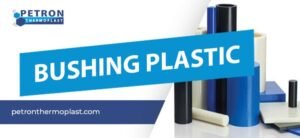Five Causes To Change Plastic Bushings
Do you require plain bushings for your application? Consider your options carefully before choosing plastic for your bushings (also known as bearings and sleeve bearings). Contrary to ball bearings, plain bearings are a straightforward-looking component with no moving elements. However, the performance of the bearing is significantly influenced by the material. Plastic bushings appear to be the simple answer since they are readily available, affordable, and have several functional benefits. Bushing Plastic has a low coefficient of friction, is self-lubricating and requires no maintenance.
However, quality, dependability, and performance are crucial while searching for the best bushings for heavy loads or high temperatures. By adding the simplest and quickest choice to your shopping basket, you will be wasting the work and effort that went into designing the mating components.
We’ll go through the top 5 reasons plastic bushings might not be the ideal choice for your application while also offering a superior substitute.
Plastic Bushings Can Be Noisy
There has been a significant trend toward quieter engines in the car sector. Morning commutes that are silent and smooth are seen as badges of excellence. A low-noise engine has one drawback: the driver and passengers can hear every rattling, little tick, or click. Therefore, there is now a push among vehicle engineers to find the quietest components. To have the proper clearance, a plastic sleeve bearing must either fit perfectly, failing which it may rattle and be heard within the cab.
Bushing Plastic does not often have precise dimensional tolerance, which necessitates precision manufacture. Although we all value precision, it isn’t always the best option. When it comes to clearance, there is a chance that the metal shaft and the bushing may shift, which results in an unattractive rattling. Contrary to tougher plastic, the softer PTFE offers noise-dampening qualities that significantly reduce sounds—even when there is clearance with a metal shaft. Based on laboratory tests at a 2 mm clearance and a 20 Hz stimulation frequency at a 40 m/s2 acceleration, Figure 1 depicts the rattling noise produced.
PTFE Bearings Have Superior Tolerance Compensation
The capacity to sustain constant torque is another benefit of using PTFE as a bushing material. It produces a more flexible sleeve bearing that maintains consistency throughout the range of tolerances present in the mating components of our clients. You won’t need to utilize expensive precision manufacturing because of its improved tolerance.
Plastic bushings regularly outperform other bushings over a wide variety of parameters. While ensuring smooth, consistent adjustments, the layer of the low-friction compound can account for the mating component’s tolerances.
Plastic Bushings Can Misalign
Misalignment may result from the placement tolerance of automobile components. The mechanics of automobile seats serve as an excellent example of this, where even something as basic as a Bushing Plastic may have a real, unfavourable effect on the driving experience. Stamping is used to create mounting holes on the seat frame. This approach is susceptible to changes in the locations of the holes. The torque will rise if the cross tube and the two sides of the seat are not exactly aligned (Figure 3). Using a plastic bushing by the automaker will push against one side of the shaft, increasing pressure and friction. The driver notices, we assure you.
Plastic Bushings Have a Lower Load Capacity
Plastic materials are limited in heavy load applications unless a metal supporting layer supports them. Once more, we’ll examine how this impacts the pivot points for seat height adjustment. Plastic is prone to cracking under severe loads, which can pressurize the mated components. This may lead to damage as well as an increase in friction. Distributing the load safeguards both the Bushing Plastic and its mate components.
Plastic Bushings Can Fail After E-Painting
Complete assemblies of bushing and mate components are frequently painted together on assembly lines to produce new items at high rates. E-painting (electrophoretic deposition) at high temperatures is used to accomplish this. Effective? No, but efficient! The metal mating components may expand as a result of the high temperatures, and the bushing material may soften. This causes the plastic to thin down permanently, resulting in higher clearance and reduced torque levels. The rattling mentioned in point 1 is the predicted outcome. Choosing a bushing with a metal backing will address this issue. A steel backing offers larger load capacities while lowering the possibility of plastic deformation.
Don’t compromise on service life and higher performance when specifying or choosing components because of short-term gains. In every application, PTFE bearings are far better than plastic ones. PTFE which is abrasion resistant is a fantastic all-purpose material for many components. It has strong chemical resistance, is an insulator with a high tolerance to heat, and is a solid lubricant that may be utilized in damp settings.
Thanks to Patron Thermoplast’s experience during the design stage, your application will function at the greatest level. Bushing Plastic might ruin all your work, so incorporate superior bearings and complementary components from the beginning. Visit our website now!



